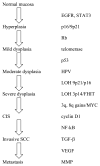Molecular changes in the multistage pathogenesis of head and neck cancer
- PMID: 22112483
- PMCID: PMC3409637
- DOI: 10.3233/CBM-2011-0163
Molecular changes in the multistage pathogenesis of head and neck cancer
Abstract
Head and neck squamous cell carcinomas (SCCHN) arise in the mucosa of the upper aerodigestive tract at multiple anatomic sites. While tobacco and alcohol exposure remain the primary risk factors for this malignancy, infection with the human papilloma virus is emerging as a major contributing factor to cancers that arise primarily in the oropharynx. Despite therapeutic advances, survival has remained relatively unchanged over the past few decades. Increased understand of the cellular and molecular biology of these cancers will improve our understanding of this malignancy and facilitate the development of more effective therapeutic strategies. Alterations that have been studied to date include genetic and epigenetic changes. While the epidermal growth factor receptor (EGFR) is the only established molecular therapeutic target, other proteins and pathways are under active investigation to determine their contribution to SCCHN carcinogenesis and progression.
Figures
Similar articles
-
Squamous cell carcinoma of the upper aerodigestive tract: precursors and problematic variants.Mod Pathol. 2002 Mar;15(3):229-54. doi: 10.1038/modpathol.3880520. Mod Pathol. 2002. PMID: 11904340 Review. No abstract available.
-
Molecular mechanisms of head and neck cancer.Expert Rev Anticancer Ther. 2008 May;8(5):799-809. doi: 10.1586/14737140.8.5.799. Expert Rev Anticancer Ther. 2008. PMID: 18471051 Free PMC article. Review.
-
The checkpointkinase 2 (CHK2) 1100delC germ line mutation is not associated with the development of squamous cell carcinoma of the head and neck (SCCHN).J Negat Results Biomed. 2010 Dec 25;9:10. doi: 10.1186/1477-5751-9-10. J Negat Results Biomed. 2010. PMID: 21184685 Free PMC article.
-
Genetic progression model for head and neck cancer: implications for field cancerization.Cancer Res. 1996 Jun 1;56(11):2488-92. Cancer Res. 1996. PMID: 8653682
-
p53 mutations and p53, Waf-1, Bax and Bcl-2 expression in field cancerization of the head and neck.Anticancer Res. 1998 Nov-Dec;18(6B):4741-9. Anticancer Res. 1998. PMID: 9891551
Cited by
-
Prognostic significance of the tumour-adjacent tissue in head and neck cancers.Tumour Biol. 2015 Dec;36(12):9929-39. doi: 10.1007/s13277-015-3755-x. Epub 2015 Jul 14. Tumour Biol. 2015. PMID: 26168959
-
Tumor-infiltrating immune cells promoting tumor invasion and metastasis: existing theories.J Cancer. 2013;4(1):84-95. doi: 10.7150/jca.5482. Epub 2013 Jan 5. J Cancer. 2013. PMID: 23386907 Free PMC article.
-
Quantitative proteomic analysis of serum proteins from oral cancer patients: comparison of two analytical methods.Int J Mol Sci. 2014 Aug 18;15(8):14386-95. doi: 10.3390/ijms150814386. Int J Mol Sci. 2014. PMID: 25196439 Free PMC article.
-
Detection of clinically relevant copy number alterations in oral cancer progression using multiplexed droplet digital PCR.Sci Rep. 2017 Sep 19;7(1):11855. doi: 10.1038/s41598-017-11201-4. Sci Rep. 2017. PMID: 28928368 Free PMC article.
-
7-Epitaxol Induces Apoptosis and Autophagy in Head and Neck Squamous Cell Carcinoma through Inhibition of the ERK Pathway.Cells. 2021 Oct 2;10(10):2633. doi: 10.3390/cells10102633. Cells. 2021. PMID: 34685613 Free PMC article.
References
-
- Jemal A, Siegel R, Ward R, et al. Cancer statistics. CA: A Cancer Journal for Clinicians. 2008;58:71–96. - PubMed
-
- Franceschi S, Bidoli E, Herrero R, Munoz N. Comparison of cancers of the oral cavity and pharynx worldwide: etiological clues. Oral Oncology. 2000;36:106–115. - PubMed
-
- FAO. Projections of tobacco production, consumption and trade to the year 2010; Rome, Italy. 2003. p. 11.
-
- Sturgis EM, Cinciripini PM. Trends in head and neck cancer incidence in relation to smoking prevalence: an emerging epidemic of human papillomavirus-associated cancers? Cancer. 2007;110:1429–1435. - PubMed
-
- Kinzler KW, Vogelstein B. Lessons from hereditary colorectal cancer. Cell. 1996;87:159–170. - PubMed
Publication types
MeSH terms
Grants and funding
LinkOut - more resources
Full Text Sources
Other Literature Sources
Medical
Research Materials
Miscellaneous


